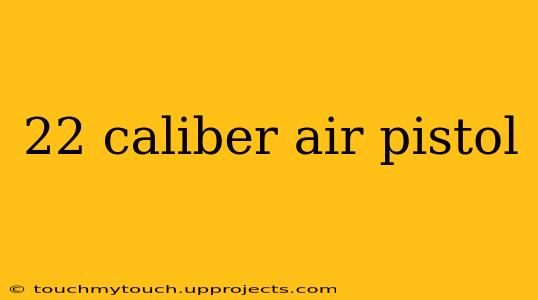The world of airguns offers a diverse range of options, and among them, .22 caliber air pistols stand out for their power, accuracy, and versatility. This comprehensive guide delves into the intricacies of these fascinating firearms, exploring their various types, applications, safety considerations, and the factors to consider when making a purchase.
Understanding .22 Caliber Air Pistols
.22 caliber air pistols, also known as .22 airguns, are categorized based on their power source:
1. Spring-Powered Air Pistols:
These pistols utilize a powerful spring and piston mechanism to propel the pellet. They are generally more affordable but require manual cocking before each shot, impacting the speed of follow-up shots. Spring-powered .22 air pistols are great for plinking and target practice on a budget. However, they often exhibit more recoil and vibration than other types.
2. CO2-Powered Air Pistols:
These pistols employ small CO2 cartridges as their power source. They are generally more convenient, offering semi-automatic or even fully automatic firing options depending on the model. CO2 pistols are known for their consistent shot-to-shot velocity and relatively low recoil, making them suitable for both recreational shooting and competitive target practice. The downside? The CO2 cartridges need replacing, increasing the running cost.
3. Pre-Charged Pneumatic (PCP) Air Pistols:
PCP air pistols are typically considered the highest-end option. They use a high-pressure air reservoir that's filled externally with a hand pump or scuba tank. This system provides exceptional shot consistency and higher power levels compared to spring or CO2 pistols. PCP air pistols, though pricier, offer significant advantages in terms of accuracy and overall performance. They are often favored by serious target shooters and airgun hunters.
Choosing the Right .22 Caliber Air Pistol
Several factors should influence your choice:
1. Intended Use:
Are you looking for a plinker, a target pistol, or something for pest control? The application directly impacts the type of air pistol you should choose. A simple spring-powered pistol might suffice for plinking, while a PCP air pistol would be better suited for serious target shooting.
2. Power and Accuracy:
Power is measured in foot-pounds (ft-lbs), and higher ft-lbs generally mean greater range and penetration. Accuracy depends on the barrel design, manufacturing quality, and the shooter's skill. Consider the level of accuracy needed for your chosen application.
3. Budget:
Spring-powered pistols are the most affordable, followed by CO2-powered, with PCP models being the most expensive. Set a realistic budget before starting your search.
4. Features:
Consider features such as adjustable sights, different pellet types compatibility, and ergonomics. Some models offer additional features like rails for accessories.
Safety First: Handling .22 Caliber Air Pistols
Always treat a .22 caliber air pistol as if it were a firearm. Observe the following safety precautions:
- Never point the pistol at anything you do not intend to shoot.
- Keep your finger off the trigger until ready to fire.
- Always wear eye and ear protection.
- Store the pistol unloaded and securely.
- Familiarize yourself with the specific safety instructions provided with your chosen model.
Conclusion:
.22 caliber air pistols offer an exciting world of shooting enjoyment, from casual plinking to serious competitive shooting. By carefully considering the factors outlined above and prioritizing safety, you can find the perfect .22 air pistol to meet your needs and enjoy years of safe and responsible shooting. Remember to always check and comply with all local laws and regulations regarding airgun ownership and use.
